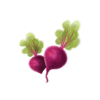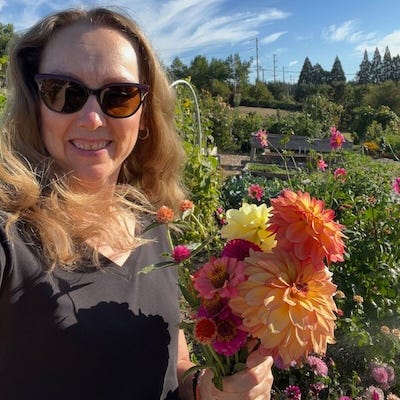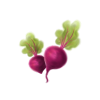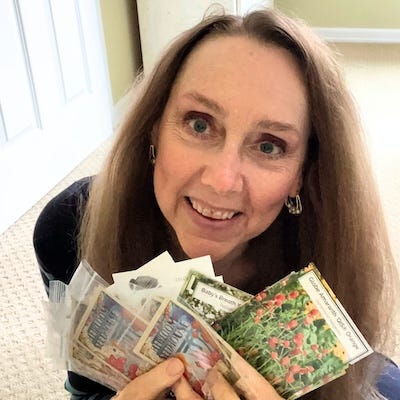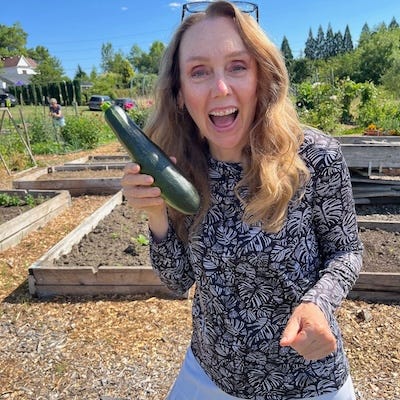5 Tips To Get Ready To Grow Vegetables This Year!
Seed-selecting tips for whatever stage of gardener you are
Welcome to Roots! A newsletter about plant-based: eating, nutrition, lifestyle, I cover it all. Join me, Lori Osterberg, as I explore good food, great health, and Gorgeous Wellth! New here? Get started.
Last week … snow. This week … in the 50s! Such is the nature of living in the Pacific Northwest at this time of year.
Give me a little bit of sunshine and 50 degrees, and I start dreaming of the days I can plant my garden. Soon - just a few weeks from now - I can sow cold-weather crops such as kale, lettuce, and radishes. Oh, how I’m itching to get my hands in the dirt again.
I’ll confess - I NEVER saw myself as a person who loves the garden. My mom and dad had a small garden in our backyard, and grew a few carrots, tomatoes, and snap peas every year. My sister and I would sneak out to the garden and pull off all the snap peas, eating them as fast as they matured on the vine. Yum …
But that tiny gardening experiment never took hold in my list of to-do’s.
Flowers on my patio to make it look pretty? Yes. Vegetables to supplement my farmer’s market purchases for a few months? Never.
Until a few years ago, when I noticed an opportunity in my local parks & recreation book. “Come and join a group of gardeners who take pride in growing their own food. Sign up for one of our community plots, and have fun growing food.”
I did a double-take. This was something we could do. I submitted my name and waited for a callback - something that took months. Who knew there’d be a waiting list for a plot to grow veggies!?
I guess plant-based living does that to a person. Once you realize you can grow your own food any way you choose, you jump at the chance. I can use natural pest deterrents and vegan organic compost to enhance each plant. I’ve learned so much over the years.
And now, this time of year, I get all excited when the first seed catalog appears in my mailbox.
Woohoo! It’s time to order seeds. Veggies, fruit, and flowers galore.
I have struggled with seeds since first starting out on this venture. I’ve planted them early inside, only to have most of them die before I can get them outside. I’ve had critters eat them faster than they could pop their heads out of the ground.
Every year is a new adventure. But I have learned a lot as I’ve gained experience. Let’s talk about it.
My Very Best Tips For Choosing Seeds
Start with a plan
I sat on the couch, flagging all the seeds I planned to order. This one. That one. Oh, and that one too.
See, I’m in LOVE with flowers. They work nicely with vegetable seeds as they bring in pollinators. More flowers, more veggies. (And I’ve decided in my next life I’m coming back as a flower farmer! 🥰)
And the bouquets - I have them in every room for a few months in the summer and fall. Gorgeous!
So, of course, I wanted all the seeds. My daughter was sitting next to me, shaking her head. “Mom …” My husband added his two cents,“We don’t have the room …”
Yes, I know. We have a 20’ x 20’ plot of land. Only so much fits in that 20’ x 20’ plot of land. And our primary goal is to grow food.
So we chunked it down. I didn’t need three somewhat similar red dahlia varieties. Just enough to add variety to my garden, and give what I needed for the bouquets I was dreaming of.
Are you learning from my dilemma? The message here is to think before you buy. Because those seed packets look very enticing when you see them on the pages of a catalog.
Take their size into account - how much space will they take?
You should also think about where they’ll grow.
Container gardens work very well when you have little space. I scatter pots all over my porch and patio with great results. But it is important to understand what grows well in limited container space.
Raised beds are a great option for expanding your growing options. You can place them anywhere you have extra space - front yards, back yards, within a garden plot. Many of our 20’ x 20’ plot neighbors have chosen to add raised beds for added protection against underground critters. It gives you a little more control over the soil used during the growing season.
Larger plots mean more variety. But don’t limit yourself to rows of the same plants, over and over again. I’ve been throwing a variety of plants together, and they do quite well! Edible flowers next to my squash plants provided just enough protection to limit the number of growing weeds.
Grow for you!
Sometimes, seeds look so enticing you forget who your garden is for. I learned that when I planted several yellow squash plants and ended up with oodles of them all over my counter. I’m not a huge yellow squash fan, and tire of them quickly. I gave a lot of yellow squash away that year.
This is your garden - grow what pleases you most. Grow the things you’ll use. Grow what you LOVE to eat and cook with. If you want 15 tomato plants, grow 15 tomato plants.
When I walk away from the garden with a basket of food, I’m excited. But when I end up with plates of food from the food I’ve grown, I’m ecstatic. Nothing is more enticing than creating meals from the food you’ve grown, beginning to end.
Pay attention to who you buy from
You only have to read a few of my posts to realize I’m not a fan of Monsanto/Bayer. For a good reason. Right now, just four corporations control more than 50 percent of the world’s seeds. This is scary at best.
If just a handful of corporations control food, it puts the entire human population at risk. We’re just starting to see the repercussions.
I believe a big start to the solution is shopping for seeds from your local farmers and community. Heirloom varieties are critical for us to adapt to climate changes and avoid food scarcity. Plus, local seeds mean they’re better equipped for the conditions you’ll find in your local area.
So, I order from places like Heirloom Seedhouse and Adaptive Seeds. A Google search can help you find the right heirloom seeds for your community.
Play with your seed-starting process
This is an art form. Trust me - I’ve been experimenting for years.
Last year, I started a bunch of heat-loving seeds early so they would have a head start when I planted them in June. They all failed. I had what was left in the packets, so I threw them in a tiny space on my plot, covered them with compost, and watered them daily. Voila! I had stuff popping up all over!
All of this is to say that seed-starting is a fickle process. The key to seed growth is light and heat. They need lots of both. A greenhouse would be lovely, but I’ve done it simply with planting trays and a grow light.
If you’re working with cold-season seeds, throw them into the garden at the right time. Hot-season seeds are where you should play with starting them indoors. Or wait for the warmer weather to hit your area.
Go into it with the right attitude
Last year, one of our plot neighbors was all-in in March. They built raised beds out of gorgeous wood. Created a drip system so their seeds and plants would be well cared for throughout the growing season. Added trellises and stakes to their climbers.
And we never saw them again.
The food went to seed!
We were stunned. With that much time and energy (and money) into it, wouldn’t you want to reap the rewards?
When I first started my garden several years ago, I started with one goal: To grow something and be able to eat it. “Just one thingy and I would be happy.” I kept saying that as we watched the plants grow.
We picked our first “thingy”, a zucchini. And it went crazy from there.
I keep that philosophy every year. I plant for the love of it. I water and weed and fertilize because I love being out there. I harvest because of the energy I put into it. I enjoy it as a meditation, as a stress reliever. Nothing makes me feel quite the way I do as I head out to the garden after a day of work, breathing in the fresh air, feeling the sunshine on my face, and seeing the results of my work.
But all of that starts with seeds.
Have you grown seeds before? What lessons have you learned from growing seeds?
p.s. Did you like this message? It would mean a lot to me if you’d press the ❤️ below if you liked it, left a comment 💬, or shared it with a friend. I’m trying to grow this publication, and I depend on people like you to do so!
And if you’re new here, Welcome! 💐 I’d love to start sharing my message with you if you’re interested in all things plant-powered, proaging, or finding kitchen joy. Subscribe … and then explore my entire archive! Glad to share with you! 🙋🏼♀️





